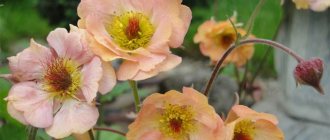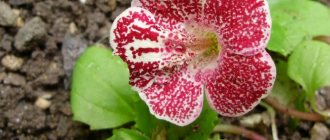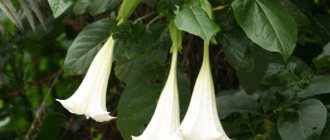There is probably no more beautiful and magnificent plant that can be grown in moist shade than buzulnik. This long-lived perennial reaches a considerable height during flowering (1-1.5 m) and grows strongly to the sides, so it is ideal for growing in large gardens or on the edge of a shaded pond. It also grows well in the shade of trees and shrubs, provided the soil is always slightly moist. In this article we will tell and show how to grow buzulnik - planting and care in open ground, photos of species and varieties.
Description of buzulnik: varieties and varieties
Buzulnik (the second name of ligularia) belongs to herbaceous perennial plants of the Asteraceae family. Under natural conditions, the flower can be found in Asia and Europe. Buzulnik (ligularia) began to gain popularity only recently, because the plant is unpretentious, blooms for quite a long time and is perennial.
Buzulnik is a perennial plant with bright flowers and original leaves.
The flower grows quite tall, can reach 2 meters. Features bright and noticeable colors that will brighten up any yard.
Interesting! In total, more than 150 varieties of buzulnik are known, but no more than 10-15 varieties are used as a garden crop.
The most popular varieties:
- Buzulnik Przhevalsky;
- Buzulnik narrow-headed;
- Siberian buzulnik;
- Buzulnik Tunguska;
- Buzulnik Tangut;
- Buzulnik angustifolia;
- Buzulnik Vichi;
- Wilson's Buzulnik;
- Buzulnik toothed;
- Kaempfer's Buzulnik.
Buzulnik Przhevalsky is one of the popular species
Most often in gardens there are varieties of Przhevalsky and jagged buzulnik. The first is distinguished by its rather tall growth and leaf shape. Flowering begins in June. This type includes:
- Light Fingered. It has beautiful carved leaves and bright inflorescences.
- Maple leaf. It is distinguished by beautiful and large leaves, similar to maple.
Buzulnik maple-leaved tree has an original shape of leaf plates
Toothed buzulnik (Ligularia dentata) is characterized by smaller growth and more rounded leaves. It begins to bloom at the end of summer, the inflorescences are collected in tassels. Popular varieties:
- Buzulnik Desdemona. The desdemona variety has light green leaves on the upper part and purple or brownish leaves below.
- Buzulnik Brit Marie Crawford. Thanks to its red leaves, it is often used in landscape design.
- Buzulnik serrated Othello. The otello variety stands out for its orange flowers and the presence of red veins on the leaves.
The same type includes dark beauty buzulnik, Osiris fantasy buzulnik, Pandora buzulnik (pandora) and Midnight lady buzulnik.
Buzulnik Little Rocket is considered narrow-headed. The variety got its name because of the shape of its flower stalks, which look like a rocket. It is able to withstand even very strong winds.
Buzulnik Othello
The differences between varieties are in their flowers, leaves, flowering time and other features. Planting and caring for buzulnik does not require special conditions, however, there are some nuances that are worth knowing before cultivating the plant.
Botanical description
The buzulnik plant grows up to 120 cm, on its straight stems there are large, up to 60 cm in diameter, heart-shaped or triangular leaves of green, greenish-violet or red-brown color on long petioles. In some species, the upper side of the leaf blade is violet-green and the lower side is purple. Sometimes only the veins and petioles of the leaves have a reddish or purple tint, and the leaf blades themselves are solid green. The basket inflorescences have a diameter of about 10 cm, their numerous tubular flowers are inconspicuous, but the marginal flowers are of bright yellow, orange and reddish shades. The baskets, in turn, form racemose, spike-shaped, corymbose paniculate inflorescences. Peduncles sometimes reach 2 m in height. Flowers in inflorescences bloom from lower to upper from mid-June and bloom until mid-August and longer. The fruit of the buzulnik is a tufted achene.
- Growing heather - how to plant, what conditions are needed, how easy it is to propagate
Planting site, soil
Buzulnik is an unpretentious plant, but you should approach the choice of soil responsibly in order to get a beautiful flower in the future.
Buzulnik Przhevalsky - planting and care
For planting, it is better to choose shaded areas with fairly moist soil. The culture does not like too much sun and begins to fade. When planting in dry soil, the result will be similar.
Fertile soil with a good amount of nutrients is the best option for such a plant. If the volume of humus in the ground is insufficient, a mixture of garden soil with humus should be added to the holes before planting; ash and superphosphate can be used.
Note! Plants are planted in two ways - seeds and seedlings.
Planting from seeds
It is better to plant seeds in the spring, when the snow has melted. They are poured into open ground to a depth of about 1 cm. The soil should remain moist until the first shoots appear. Then the seedlings are protected from direct sunlight until they grow and become stronger.
The best time to plant buzulnik seeds is considered to be late autumn and early winter. In this case, they undergo natural stratification, and the plants from them become stronger and more powerful.
Buzulnik seeds
Planting seedlings
Sowing seeds for seedlings begins in January and continues until March:
- Holes are made in the container.
- Nutrient drainage approximately 1 cm high is poured onto the bottom and covered with soil, which must be thoroughly moistened.
- Seeds are laid on the surface, sprinkled with 5-7 mm of soil, and moistened again.
- Cover the container with film or glass and monitor the humidity.
- When sprouts appear after some time, the shelter is removed.
If necessary, small plants are illuminated. After two leaves appear, the flowers can be transplanted into separate containers. Planting in open ground is carried out in May, when the threat of night frosts has disappeared.
Important! Flowering of a plant obtained from seeds begins only when it reaches about 4-5 years.
The plant does not need to be replanted. Buzulnik feels great in one place for quite a few years. However, experts recommend updating the bushes by dividing every five years. During the flowering period, replanting cannot be carried out.
Garden care
Since buzulnik is mostly grown in garden plots, it is important to take into account all the features of caring for this plant. Unlike most other flowers, it prefers shady areas, but there are other characteristics.
Watering
The introduction of water into the soil should be stable and carried out more often during the period when the plant is developing. It is important to ensure that the soil is kept moist at all times.
However, if the plant is in a wetland or is in the stage of active growth or creating buds, you should not over-water. For this procedure, it is recommended to use water at room temperature.
If buzulnik is grown in pots and a large amount of water has formed in the tray after watering, it must be drained. In hot summers, it is recommended to water the plants from top to bottom with water at a temperature of about 35-40°C.
In autumn, the frequency of watering is reduced. However, everything depends on the ambient temperature. In winter, it is enough to simply protect the soil from drying out. It is necessary to resume active watering in the spring, when the plant begins to show signs that growth has begun.
Top dressing
Buzulnik (planting and care, photos and care tips will help you quickly get healthy plants) is recommended to be fed every 14 days with mineral fertilizers, which are usually used for any other flowers during the growing season.
After the buzulnik has flowered, the amount of fertilizing needs to be reduced, as well as the amount of nutrients in the mixtures, if the gardener prepares them himself.
In winter, fertilizers and other compounds are not introduced, since the plants are at rest. It is recommended to start feeding the buzulnik again only in the spring, as soon as young leaves have formed on it.
For the first fertilizing, it is best to use formulations that contain a high nitrogen content. This component has a positive effect on the development of flowers and the formation of green mass.
Mineral-based fertilizers can only be applied to damp soil, that is, immediately after watering. It is recommended to use humus for buzulnik. Experienced gardeners also use rotted horse and cow manure. It is recommended to alternate such feedings, then the plants will grow most actively.
Garter and trimming
It is recommended to perform the pruning procedure when the plant has already bloomed. If it is necessary to collect seeds, gardeners leave 2-3 paniculate-type inflorescences. The pruning process is required so that nutrients begin to flow more actively to the foliage and branches. If this procedure is not followed, the plant will not have time to grow leaves before the first frost.
Since buzulnik is a relatively tall plant, it requires additional support during the flowering process. Although its branches seem very flexible, they easily break from the wind or under the weight of heavy and large inflorescences. The garter is always made for those types of buzulnik that are distinguished by inflorescences in the form of panicles.
Watering and loosening the soil
During the growing season, it is recommended to increase the amount of watering, because the plant loves moisture very much. However, waterlogging and swampiness should not be allowed. Buzulnik also does not like drought and tolerates it very poorly.
Checkerboard hazel grouse: planting and care in open ground
In the warm season, the crop can be sprayed, but not in the daytime, but in the early morning and evening to avoid sunburn on the leaves.
Periodically loosening the soil will help moisture reach the roots faster. In addition, loose soil is better saturated with oxygen, which is also necessary for the root system.
Note! Loose soil dries out faster, so it is important to combine watering and loosening so that the plant feels comfortable.
Loosening the soil saturates it with oxygen
Reproduction methods
Buzulnik can be propagated in two ways - by seeds and by dividing the bush. Each has its own characteristics.
Mock orange (jasmine) - planting and care in open ground
Growing from seeds takes longer:
- When the seeds have fully ripened on the bush, they are collected and thoroughly dried.
- Sowing is carried out in autumn in a separate place to a depth of 2 cm. In this case, the seeds will undergo natural stratification and sprout together in the spring.
- When the plants grow a little and become stronger, they can be transplanted to a permanent place. Buzulnik will bloom only after 4 years.
Important! In bright varieties with burgundy leaves, seed germination is not very good. To reproduce them, it is better to use another method.
Reproduction by dividing the bush requires less effort and time:
- To do this, the rhizome of the bush is cleared of soil and carefully divided into several pieces. Each one must have at least one kidney.
- The bushes are planted in 40*40 holes with added humus. It is recommended to immediately add mineral fertilizers, which will help the plant quickly adapt to the new location.
- The sprout must be watered.
It is better to carry out this procedure in early spring, when the growth of new shoots becomes noticeable. If the bush is very large, you don’t even have to dig it up, but simply separate the necessary part with a shovel. This must be done carefully so as not to damage the entire rhizome.
Plant propagation by dividing the bush
Varietal diversity
Ligularia dentata is distinguished by significant varietal diversity. Breeders have bred not only plants with green leaves, but also very decorative purple, beet red, and bronze ones. The most popular varieties survive even severe Siberian frosts without unnecessary difficulties and feel great in the climate of the Moscow region.
Buzulnik Vorobyova
Buzulnik Vorobyova photo and description of the plant
Also a native of central China. It is impossible not to notice it, simply a giant for a garden flower - up to 120 cm in diameter and 200 cm in height. The power is also felt in the dense, leathery leaves of a dark green color. Yellow flowers are collected in large racemes and bloom in August.
Serrated
It grows well, reaches a height of 100 - 110 cm. It is distinguished by bright serrated leaves, from the shape of which it got its name. The inflorescences are yellow in color: from light to brown. Thanks to its decorative appearance, it is valued by gardeners. The plant is planted along the path, under a fence or in the center of a large flower bed.
The most popular subspecies of serrated ligularia are the following:
- Desdemona;
- Othello;
- Marie Crawford;
- Osiris.
The plant begins to bloom in mid-summer. Flowers fall in early autumn.
Buzulnik Tangut
Unlike any other! It has a thin carved leaf and a very delicate inflorescence. It blooms with lemon-yellow flowers starting in August. In landscape design, it is usually used to combine several types of shrubs into a single composition.
Buzulnik Vicha
It is distinguished not only by its bright yellow flowers, but also by its decorative rosette of leaves: large, dark, glossy, shaped like a heart. Can reach more than 2 m in height. Flowering begins in August and lasts up to 40 days.
Buzulnik Siberian
It is distinguished by large heart-shaped green leaves. It blooms with yellow baskets collected in a narrow brush. Reaches a height of 1.40 m. A similar but dwarf species is called arctic buzulnik.
- Buzulnik angustifolia Rocket (The Rocket)
Hybrid of narrow-headed buzulnik and Przhevalsky. In inflorescences it is similar to Przhevalsky's buzulnik, but has decorative foliage with larger teeth.
Wilson's bush Ligularia wilsoniana
Wilson's bush Ligularia wilsoniana photo
Homeland - China. The plant is prominent, up to 1.5 meters tall, the leaves are kidney-shaped, grow on a long petiole, the flowers, on the contrary, are small, yellow, collected in small inflorescences. The variety is quite frost-resistant, but not so much that it can winter without shelter.
Przewalski's buzulnik (Ligularia przewalskii)
This plant is undemanding and unpretentious. It is often used to decorate those areas of the garden that do not look very beautiful. The bush reaches a height of 150 centimeters, it has spike-shaped inflorescences and rugged leaf blades (similar to maple ones). Such a flower, despite its monumentality, looks very elegant. Flowering begins in the last days of July.
Varieties:
- Rocket. The height of the peduncles, which point upward, reaches 200 centimeters. They have a huge number of baskets-inflorescences of yellow color. The brownish-red shoots are very strong and do not need support. The leaf blades are almost round, heart-shaped, with a sharp-serrated edge. In summer the leaves are green, and in autumn they are raspberry-burgundy.
- Maple leaf. The leaf blades have a maple shape. They are very large (larger than Rocket), their diameter is about 25 centimeters. The bush can reach 1.7 m in height.
Buzulnik Hessi
Buzulnik Hessie Ligularia hessei Gregynog Gold photo
It is very similar to jagged buzulnik - heart-shaped leaves, daisy flowers, height up to 150 cm. However, it has one feature unusual for buzulniks - this shade-loving plant will withstand direct sun, so you can use it in a sunny mixborder.
Variety Desdemona
The toothed buzulnik Desdemona, magnificent in its appearance, the photo of which is presented below, is liked by many gardeners. Picturesque wavy leaves with double color grow in a lush head on the lawn, attracting attention. The plate is painted violet-brown below and dark green above. The buds open in August. They have pointed yellow petals with a dark middle. The height of the bush is no more than 90 cm.
This variety looks beautiful in garden design. Look how well Desdemona’s buzulnik emphasizes the spaciousness and comfort of a summer cottage (photo gallery for your attention).
Blooming Desdemona. The culture is not afraid of partial shade and grows well along a country house.
Young ligularia during autumn flowering.
Buzulnik is in close proximity to other large flower bed crops.
Midnight lady
The variety grows up to 80 cm and is distinguished by its black-purple leaves with burgundy veins. The shape is round, the surface is shiny. Flowering begins in July, with yellow chamomile-like flowers appearing on the shoots.
Pandora
The Pandora variety is a low-growing variety, reaching a height of no more than 30-40 cm. Suitable for growing in pots and tubs, the leaves are very decorative, purple in color, with long petioles. The flowers are chamomile-shaped, orange-yellow. The flowering period occurs in July.
Buzulnik Vicha (Veitchiana)
A separate type of buzulnik.
The plant is up to 2 m high, the leaves are green, heart-shaped, with a carved, sharp-toothed edge. Fully opened, they reach 40 cm in diameter.
Flowering begins in August and lasts about 1-1.5 months. The inflorescences are elongated pyramidal, the flowers are small yellow.
Buzulnik Gregynog Gold
Hybrid of buzulnik serrated and buzulnik Wilson.
The plant is up to 2 m high, the bush is compact, the leaves are bright green, heart-shaped, triangular, with a carved, finely toothed edge and a rounded end.
Flowering begins in August and lasts about 1-1.5 months. The inflorescences are baskets in large lush corymbs, the flowers are bright yellow and medium-sized.
This is how he is, a bright and unpretentious bully. If you have been wondering for a long time how to “refresh” the appearance of your usual plot without much hassle, why not add this wonderful perennial to your home?
Othello variety
A distinctive feature of Othello is its spreading leaves, reaching about 40–50 cm in size. The plant looks beautiful on the shore of an artificial pool and a natural pond. The characteristic leaf color of serrated ligularia becomes especially bright closer to autumn. Buzulnik Othello, photos of whose flowers are collected in a separate gallery below, blooms at the end of August. Flowering lasts a little over a month.
The petals of small flowers of the Othello variety are bright yellow.
Buzulnik The Rocket
Hybrid of narrow-headed buzulnik.
The plant is about 0.9 m high, the open leaves reach 30-35 cm in diameter. The leaves are heart-shaped, sharply serrated, green in spring and summer, purple-crimson in autumn. They are dense, with noticeable textured venation.
Flowering begins in mid-July and lasts about 1.5 months. The inflorescences are arrow-shaped, bright yellow, the flowers are medium-sized (about 3-4 cm in diameter), on straight dark peduncles up to 2 m high.
Dark beauty
The Dark Beauty cultivar is a tall variety, reaching 1 m in height. The basket-shaped inflorescences are bright yellow, reach a diameter of 9 cm, and are collected in panicles.
Black purple
A luxurious variety in its decorativeness, one of the most popular in landscape design. Tall, up to 100 cm, quite cold-resistant perennial, blooms in summer, produces large yellow buds up to 9 cm in diameter. The leaves are purple with an intense black tint.
Variety Osiris
Buzulnik Osiris is the smallest and most charming subspecies of serrated ligularia. It is planted in a flowerbed in a row of medium-sized plants. The height of the bush reaches no more than half a meter. Osiris thrives alongside other perennials, such as phlox or New Belgian asters. All summer it is full of rich green leaves, and by mid-July it blooms with small lemon “stars”. Flowering duration is approximately 40 days.
Variety Marie Crawford
Marie Crawford's buzulnik (photo of varietal plants in the garden design below) is distinguished by the original color of its leaves. They combine several shades at once: from purple to brown, from marsh to malachite. A spreading bush with large leaves grows about a meter in height. Flowers rise like a fiery cap above the leaves from August to September.
Marie Crawford variety in an English garden next to perennial herbs, lilies, ferns and shrubs.
Feeding and replanting
Buzulnik really likes feeding and fertilizers. You can use both organic and mineral substances.
If humus was added to the hole when planting, then for the first year of development the crop will not need anything else. In the future, it will need to be fed every year before flowering begins. Mullein is used for this purpose. Take 1 liter of substance per 10 liter bucket, mix everything well and apply it under each bush. One plant will require 3 liters of solution, which is watered with it once every couple of weeks.
Additional Information. Feeding is carried out every year. If weather conditions change sharply, fertilization is not carried out.
Mineral fertilizers are applied only to abundantly moist soil, after the crop is well watered. In the fall, experienced gardeners recommend pouring mulch into the root zone; it is better to use humus for this purpose. In the spring, everything is dug up, as a result the soil and plant receive nutrients. You can use wood ash to feed the flower.
Reproduction of buzulnik by dividing the bush
If you want to propagate and rejuvenate the plant, you can use its division. A mother ligularia that has grown in one area for 5–7 years is ideal for this purpose.
To separate planting material from the bush, in early spring, before the active growth phase begins, use a shovel to cut off part of the plant, carefully dig it out, and fill the remaining hole with a substrate of garden soil mixed with humus. After this procedure, the mother bush should be moistened abundantly.
The seedlings obtained for propagation must be divided so that each of them has several fertile buds. After this, the planting material must be washed and the cut areas treated with activated carbon.
The seedlings are planted in holes whose depth and width are 40 centimeters. Before placing plants in them, the holes must be filled with a mixture of garden substrate, humus and mineral fertilizers, and then planted.
Pruning Buzulnik
In general, Buzulnik does not need pruning. It grows well this way. However, old wilted leaves and shoots should be trimmed to the very root with pruning shears.
If propagation by self-sowing is not planned, then immediately after flowering the peduncles should be removed. As a result, until winter only a lush bush with beautiful leaves will remain. The tops are almost completely cut off for winter.
After flowering, the plant's flower stalks need to be trimmed.
Pests and diseases
Buzulnik is quite rarely exposed to diseases and pest attacks.
The most common disease of this flower is powdery mildew. Increased humidity and heat contribute to the development of such pathology. The disease can be recognized by the following signs:
- Powdery spots appear on the leaves. At the initial stage, they are easily washed off.
- Over time, the lower part of the leaf blades becomes damaged and becomes covered with brown spots.
- The leaves begin to dry out and crumble, and the plant gradually dies.
The problem must be combated with special fungicidal agents. The preparations Topaz and Hom are suitable for this purpose.
Additional Information. To prevent fungal diseases, it is recommended to spray with sulfur and whey. Irrigation is carried out up to three times per season.
During the period of budding and flowering, nitrogenous fertilizers should not be used for feeding. It is better to give preference to substances with potassium and phosphorus. They have a beneficial effect on the entire plant and increase its resistance to various diseases.
Pests attack Buzulnik quite rarely, but the plant can suffer from slugs. They eat leaves and stems. Controlling these pests is not easy and must be started early. The procedure includes several steps:
- While digging up the area, weeds are removed.
- Prepare small trenches, at the bottom of which pepper, tobacco dust, sand, ground eggshells are poured - substances that will prevent the parasite from getting close to the flowers. You can place water bottles in the grooves to create a natural barrier.
- It is permissible to pour gravel between the rows and bushes.
- To get rid of pests, birds are attracted to the site and feed on them.
- Fertilizers help well - superphosphate and potassium salt. If you periodically scatter them near the plantings, then there will be practically no slugs there. The substances are harmful to them. The entire amount of the drug is divided into two parts and scattered at intervals of 40 minutes.
You can deal with slugs by collecting them manually. However, not every gardener is ready for this. If desired, you can use chemicals, for example, the drugs Thunderstorm, Meta.
In addition to slugs, snails can damage flowers. They are fought with similar methods and means.
Application in medicine
Some varieties of the buzulnik plant are used in folk medicine. For example, an infusion is prepared based on the bluish species, which helps to calm the nervous system during irritability and poor psycho-emotional mood.
To prepare, pour a tablespoon of the plant into a glass of boiling water, leave to infuse for 3 hours in a warm room, then strain. Take one tablespoon three times a day on an empty stomach.
Blue buzulnik is also used to combat arthritis. Based on it, you can make the following preparation: pour 2 tablespoons of the herb into 2 glasses of water, put on fire and boil for 5 minutes, then leave for 2 hours, strain. Take a third of a glass three times a day.
A variety such as Fischer's buzulnik helps in lowering body temperature. To prepare the medicine, pour 300 ml of boiling water over a tablespoon of crushed inflorescences, let it brew for 60 minutes, then strain. Drink half a glass three times a day.
Fischer's buzulnik helps in lowering body temperature
Flowering period and care
Depending on the variety of plant, buzulnik blooms at different times. During this period, you need to monitor the soil moisture, apply fertilizing if necessary, and remove wilted flowers.
Care after flowering is just as important for the plant. To prevent the seeds from ripening and spreading throughout the site, the flower stalks are cut off.
Planting material is collected as follows:
- Choose good strong inflorescences.
- Place cotton bags over them and secure them tightly.
- The remaining cuttings can be removed.
- After ripening, the flowers are cut off, and the seeds are peeled and dried.
- They need to be stored in paper bags.
After flowering, the plant is trimmed and left until late autumn so that it gains strength for the winter period.
Hybrid Gregynog Gold
The hybrid buzulnik Gragenog Gold was bred by crossing two varieties: Vicha and carved jagged. Thanks to successful selection, a tall ornamental plant appeared, crowned with warm, sunny flowers. The bush grows compactly: with a height of up to 150 cm, the width is no more than 45 cm. The heart-shaped green mass is painted in a light shade of green with golden reflections. The culture grows well in moist soils and tolerates partial shade. In winter it does not require additional care.
Preparing for winter
Buzulnik tolerates cold temperatures and frosts well. In autumn, all branches of the crop are almost completely cut off. Humus is poured over the flower, then foliage. If desired, the plant can be covered with covering material, but this is not necessary.
Important! In winter, more snow needs to be poured in place of the bush. Under such cover the flower will easily survive the cold season.
Designers love the plant for its beautiful appearance and unpretentiousness.
Use in landscape design
There are many varieties of buzulnik. Landscape designers love culture and often use it to decorate areas. The flower grows well in recreation areas. When located near bodies of water, the bush will provide shade on the water, creating excellent living conditions for fish.
The crop grows quite tall, so it is recommended to plant it near any fences so that the branches do not break from the wind. Smaller flowers and different colors will look great against the background of the buzulnik.
Buzulniki, all varieties and types of which are very beautiful, are popular with many gardeners. The culture is quite unpretentious, practically not affected by pests and diseases, and is decorative. Planting and caring for buzulnik in open ground does not require a lot of time and knowledge.
Ligularia Vorobyova
Another grand representative of the Astrov family. The powerful bush grows up to one and a half meters wide, while its height is sometimes more than two meters. In sufficiently rainy weather, the rounded thick leaves of the Far Eastern plant grow up to 50 cm in length. The culture blooms quite late. Dark leathery stems appear in late August and produce small yellow flowers until late September. This species tolerates winter well and is adapted to harsh climatic conditions.











